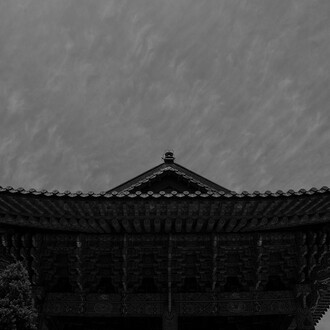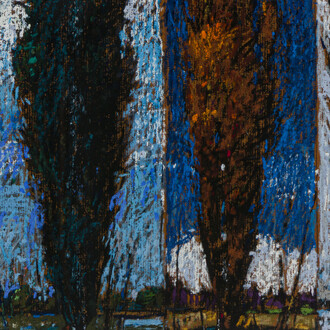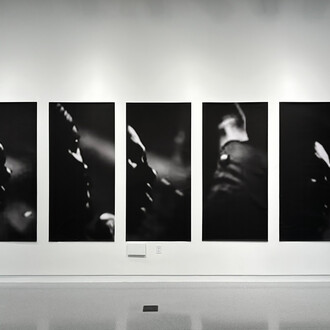Ilan Averbuch’s The Lily Pond is an immersive installation, a visual metaphor of an aquatic environment. The installation comprises 14 sculptures displayed on large recycled granite millstones, dispersed through the gallery. The stones are raised off the ground, creating a field of seemingly floating round platforms reminding us of large lily pads on the surface of a pond.
A large stone boat is installed at the entrance of the gallery titled The Ark After Paris, elevated on stilts, creating an illusion that it is floating in mid-air. The work conjures images from early mythological stories of floods, while acknowledging the current political climate, the reality of melting glaciers and rising sea levels. The boat becomes the vessel that guides the visitor through the exhibition.
Small sculptures in steel, stone and bronze occupy the surface of each lily pad. The Contract (After Cyrus Cylinder), a stone cylinder carried by a row of bent steel forms, which suggest human bodies in movement, refers to the first declaration of human rights from 539 BCE. The Arc of the Moral Universe alludes to a quote from Dr. Martin Luther King, Jr.; the sculpture is two round millstones joined by a brittle stone arch, with each end held up in mid-air by a group of abstracted steel figures. In As Far As the Eye Can See, two open circular stone forms create a framed view, like glasses or binoculars, holding up crisscrossed steel beams. This work plays with perception and perspective, inviting the viewer to walk around the form and view the exhibition through varying lenses. The Wall is, in fact, a stone wall that separates two groups of steel forms. The title is carved into the stone, written in English on one side of the wall and in Spanish on the other side. A tension is created and instantaneously broken as the viewer is permitted (or invited) to transverse the barrier and view the work from both sides. These are a few of the sculptures that comprise The Lily Pond with inspiration as varied as the Ancient Cyrus Cylinder from 539 BCE to the recent U.S. president’s decision to pull out of the Paris Climate accord. The sculptures are made of materials and imagery imbued with age and history.
The installation is accompanied by large drawings, with direct references to the imagery of the sculptures including writing by the artist, a signature of his drawing style through the years. In the new drawings the writing pertains to the specificity of a project, amplifying the artist’s proposal. For instance, The House in the Boat, The Boat in the House, a drawing for a proposal in Germany, is back-dropped by writing introducing the work as a site-specific installation located in a large open field. A beautiful forest frames the field with low hills around the perimeter. Thus, the artist sets the stage visually and verbally. The drawings, like the sculptures, symbolically reference history, culture, landscape, dream, policy, discourse or human aspiration.
Ilan Averbuch received a B.F.A. from School of Visual Arts and an M.F.A. from Hunter College, both of New York. He also studied at Wimbledon School of Art, London. He received a grant from Pollock-Krasner Foundation and awards from Mid-Atlantic Art; D.A.A.D. (Deutscher Akademischer Austausch Dienst), Berlin; and Rhodes Family Award for Outstanding Achievement in Fine Art, School of Visual Arts, New York. His work has been shown at the Arkansas Art Center, Little Rock; Art Gallery of Ontario, Toronto; Art in the Park, New York; Bronfman Centre, Montreal; The Brooklyn Museum, New York; DeCordova Museum and Sculpture Garden, Lincoln, Massachusetts; Fort Tryon Park Project, New York; Het Apollohuis, The Netherlands; Hudson River Museum, Yonkers, New York; Hunter College, New York; Israel Museum, Jerusalem; Jamaica Art Center, Queens, New York; The Jewish Museum, New York; Katonah Museum of Art, Katonah, New York; Kunstlerhaus Bethanien, Berlin; List Art Center, Brown University, Providence, Rhode Island; Lodz, Poland Historical Museum, Lodz, Poland; Palo Alto Cultural Center, California; P.S. 1, Long Island City, Queens, New York; Robert Moses Plaza, Fordham University at Lincoln Center, New York; Socrates Sculpture Park, Astoria, Queens, New York; Tefen Museum Sculpture Garden, Israel; Tel Aviv Museum, Israel; Tel Hai Art Center, Israel; Tel Noff Sculpture Garden, Israel.
The artist’s work is represented in numerous public collections, among them: Bar-Ilan University, Israel; Brock University, St. Catherines, Ontario, Canada; Bronfman Centre, Montreal, Canada; Florida International University, Miami; Israel Museum, Jerusalem; Nevada Museum of Art, Reno; Omer Industrial Park, Israel; Open Museum, Tefen, Israel; Prudential Insurance Company of America; Newark, New Jersey; Runnymede Sculpture Farm, Woodside, California; Tel Aviv Museum, Israel; Tel Hai Art Center, Israel. Ilan Averbuch resides in New York City.
















